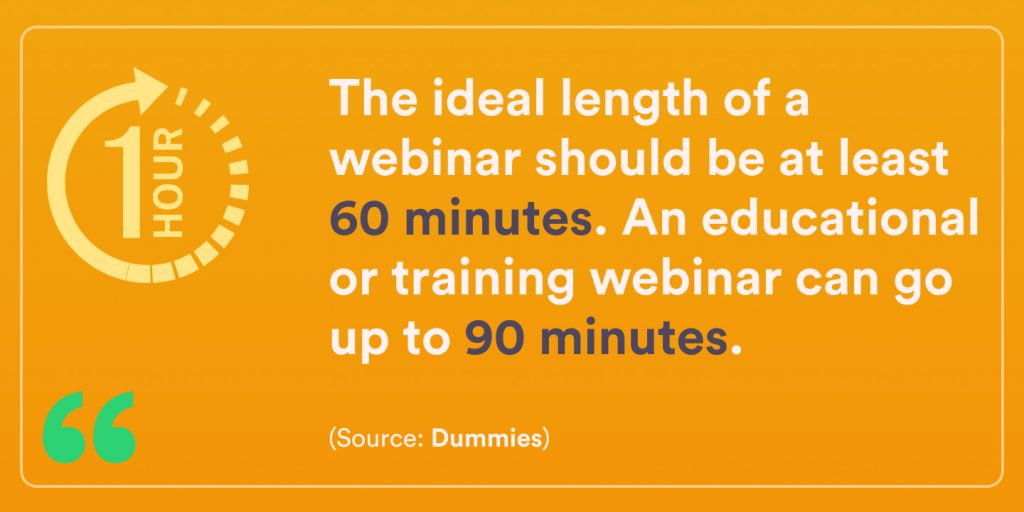What are webinar metrics and KPIs?
Webinar metrics and KPIs are often interchangeable, but that’s not always right. While all KPIs are metrics, all metrics aren’t KPIs. In other terms, a metric is a standard of measurement, and KPIs are the metrics that measure performance of an activity.
Regarding webinars, your metrics can be distributed into parts like KPIs, KBIs, and KRIs, standing for Key Performance Indicators, Key Business Indicators, and Key Risk Indicators respectively.
Some examples of Webinar KPIs could be the number of leads generated, audience engagement, referral sources to your webinar landing page, and webinar replays.
Why Track B2B Webinar Metrics and KPIs?
Tracking B2B webinar metrics and KPIs offers valuable insights that can profoundly influence your marketing strategy. They also empower you to achieve greater returns on your webinar investment.
Let’s understand why tracking webinar metrics and KPIs is important:
- Enables ROI Measurement: With webinar metrics and KPIs, you get clear and quantifiable data about your webinar performance. You can track registration rate, attendance rate, audience engagement level, conversion rate, and more which help you calculate your webinars’ return on investment (ROI).
It actually helps you identify which aspects of the webinar drive the most significant return on investment and which ones need improvement. This data-driven approach plays a major role in optimizing the webinar strategy, improving future programs, and ultimately achieving a higher return on investment. - Get Audience Engagement Insights: Looking at the engagement metrics can significantly assist you in understanding your audience’s interests, preferences, and behaviors. Through poll & survey responses, Q&A participation, and chat interaction, you will easily know the audience’s interests, preferences, and behaviors as well as identify the most effective engagement channel.
(For example, your audience engagement rate is 70% and the average watch time is 45 minutes out of 60 minutes of webinar. That means the webinar topic is relevant to your target audience and they found out content engaging & informative.) - Track Leads: You can track how many of your webinar attendees convert into leads. By using the webinar platform’s integrated CRM software like Salesforce and Hubspot, you can capture and manage lead data with ease. Tracking webinar leads not only helps identify high-quality leads but also enhances your marketing and sales strategy. You can segment each lead based on their engagement and run a highly targeted B2B lead nurturing campaign to maximize conversions for your business.
- Optimize Future Webinars: It is essential to evaluate your current webinars in order to better future ones. It can help you gain insights into attendance rate, audience preferences, leads generated, and more. By analyzing data from current webinars, you can identify areas for improvement and make informed decisions to optimize your webinar strategy to get maximum results.
(For example, 100 people registered for the event but only 50 attended the webinar. This means you fall short of reminding your people about your event. Next time, you will need to send reminder emails to each registered attendee with personalized subject lines.
Another example is if your webinars generate a large number of leads but the conversion rate is very low, you may need to invest in lead nurturing campaigns or improve sales follow-up processes.) - Improve Content Strategy: If you measure B2B webinar performance metrics, it can help you assess the effectiveness of your content and its delivery efficiency, as well as learn which webinar topics were most popular with your target audience. Knowing this will help you tailor future webinar content to better suit the specific needs and interests of your audience.
(For example, if your webinar has high registrations and high attendance but low engagement, this may indicate that the topic was not relevant to the target audience or that the content delivery was ineffective.
In that case, you can collect feedback after the webinar to learn what attendees didn’t like or enjoyed so accordingly you can refine your content strategy for the next event and align topics with audience interests.)
What is the Difference Between Webinar Metrics and KPIs?
Feature | Webinar Metrics | Webinar KPIs |
Definition | Webinar Metrics are specific measurements used to track the performance of a webinar | Webinar KPIs are known as key performance indicators that measure the success of a webinar, such as lead generation |
Purpose | The purpose is to understand the performance of various aspects of the webinar | The goal is to assess the overall effectiveness of the webinar in achieving business objectives |
Examples | Registration rate, attendance rate, average time spent, poll responses, video views and more | Lead generation, conversion rate, cost per lead, ROI, and more |
Webinar Metrics and Webinar KPIs Examples
Before we dive deep into the most important webinar success metrics, here’s a quick look at what webinar metrics and KPIs look like.
Metric | Webinar KPI |
Registrations | Yes |
Attendance Rate | Yes |
Engagement Level | Yes |
Pipeline generated | Yes |
Revenue Generated | Yes |
Number of Leads Generated | Yes |
Average Duration | Yes |
Q&A Participation | Yes |
Email open and click rates | No (It’s a metric that contributes to a KPI–Signups) |
Email conversions | No (It’s a metric that contributes to a KPI–Signups) |
CTA conversion rate | Yes (It’s a metric that contributes to a KPI–Number of leads generated) |
The Most Important Webinar Metrics & KPIs to Measure for Success
Now that you know why webinars are important, here are the top 10 metrics that you should consider to measure the success of your B2B webinar.

1) The number of registrations vs. CTR
Tracking and engaging with your audience when they sign up for your webinar is definitely one of the key metrics for a successful webinar.
But there’s a catch. If you feel that your click-through rate is high, and registration is low, you might want to re-check a few things.
- Does your registration landing page have the right CTAs?
- Are the CTA clear and standing out?
- Is your copy concise?
- Does your copy capture the essence of your webinar completely?
One of the most important metrics when it comes to webinars, ensure that you measure it right.
How will this data help? It will help understand,
How strong your attendance vs. registrations are
The effectiveness of your registration landing page
The value proposition of your webinar to your B2B customer
As per industry standards, if your CTR is less than 25%, you should reconsider your webinar topic and landing page – as nothing is connecting with your audience.
Remember, these numbers will also help determine your upcoming webinars and the right online marketing tools that you should use to promote.
Pro tips from Airmeet: To boost your registration process, here are a few things that you can include in your campaign –
- Clear description of your content – Ensure that your landing page clearly mentions the speakers, expert panel, webinar format, and content formats. Establish yourself as a subject matter expert.
- Social media – Promote on LinkedIn, Twitter, and Facebook. Include the value prop of the webinar (as in why should your target audience attend this) and choose the right audience.
- Paid promotions – Use Facebook Ads and Google Ads to target your community.
- Email marketing – Use emails extensively to reach out to your patrons who can share more about your event.
2) Cost of the webinar
Webinars are cost-effective than most average marketing campaigns, but they soon become more expensive if not planned correctly.
When measuring the cost of the webinar, keep track of the costs involved in promotional activities and marketing resources or online marketing tools being used. Besides this, you should also be aware of –
- What was the cost per registration by channel?
- What was the cost per registration by audience segment?
With time, and with the follow-up of your post-webinar and lead nurture, you’ll also be able to determine the cost per MQL, SQL, qualified leads, sales opportunity, closed won leads, etc.
3) Attendee turn-out ratio
Webinar KPIs and webinar performance metrics like these measure the number of registered attendees who actually attended the webinar. These webinar metrics can be calculated by dividing the number of actual attendees by the total number of registered attendees and expressing it as a percentage. It provides insights into the effectiveness of your promotional efforts in driving attendance.
4) Attendee drop-out ratio
This webinar metric indicates the number of attendees who left the webinar before it ended. It is calculated by dividing the number of dropouts by the total number of attendees and expressing it as a percentage.
5) Attendee intent signals
These are indications or behaviors exhibited by attendees that indicate their interest or intent to take further action like making a purchase or signing up for a demo.
Intent signals can fuel your sales and customer success teams with insights to highly personalize their campaigns and improve their efficiency. It also allows the marketing teams to align with sales closely.
Some key intent signals to track can include asking questions about product details, requesting a demo, or expressing interest in purchasing. Tracking and analyzing attendee intent signals can help identify potential leads and gauge the effectiveness of the webinar in driving desired outcomes.
You can also capture attendee intent via webinar feedback forms.
However, this can be classified as just a metric and not a KPI.
6) Number of webinar replays and on-demand requests
This metric refers to the number of views or plays the recorded webinar receives after it has been made available for on-demand viewing. It helps measure the long-term impact and reach of the webinar beyond the live session and provides insights into audience demand for accessing the content at their convenience.
7) Webinar to sales
This webinar metric measures the direct impact of the webinar on sales conversions. It tracks the number of attendees who converted into paying customers or made a purchase as a result of attending the webinar. Calculating the webinar-to-sales ratio helps determine the webinar’s effectiveness in generating revenue.
8) Influenced pipeline
This webinar KPI can be tracked to measure the financial success of a webinar. Use it to assess the impact of the webinar on the sales pipeline or sales funnel. It measures the number of potential leads or prospects that were influenced or moved forward in the sales process as a result of attending the webinar.
This metric is valuable for evaluating the webinar’s role in generating leads and contributing to the overall sales pipeline.
9) Webinar view duration
In this world of Zoom fatigues and brevity, webinars (as a marketing tool) may be assumed a dead format. But that’s not the case.
With webinars replacing in-person events and bringing communities together, it is more important than ever to measure the webinar view duration. After all, you don’t want your audience to leave, right?
The webinar view duration indicates how engaging your content, resources, and speakers were.

Pro tips from Airmeet: To boost the average viewing duration, try and engage your audience throughout the webinar. In Airmeet, you can use chat, polls, q&a, emojis to engage your audience.
For example, if you are running an educational webinar, using the polls will help you understand who is following the course or absorbing the subject matter.
Or, you can also use the upvoting feature to answer more pressing audience questions faster. In Airmeet, you can even bring the questions on the screen during the webinar event.
10) Engagement during the webinar
One of the best ways to measure the success of your event is customer feedback.
To begin with, you can start up with a simple poll nearing the end of the event itself. Post that, you can send a detailed survey and ask questions like what parts they enjoyed the most, which parts they found the most useful, and also what regarding the different kinds of content that were covered.
Pro tip from Airmeet: Surveys are best kept short; like 5-7 minutes across industries. Use this information to generate content for all of your future webinars.
11) Attendee feedback
An engaged audience = A happy audience!
Here’s the thing, no one wants a monologue. Using the interactive features (mostly available on webinar hosting platforms or virtual events platforms) will help boost engagement across the webinar.
Once the webinar is complete, check how many attendees actively participated in your polls, q&a, and when did they interact. This will help you understand drop-offs, or whether the audience connected with the webinar.
Pro tip from Airmeet: Use the customer engagement analytics, available in the events dashboard, to reiterate your webinar content, strategy, and goals.
12) Attendee to SQL - Conversion Rate
Arguably one of the most important metrics, this helps you determine how many qualified leads did your webinar really generate.
Not to be confused with the top of the funnel count (of registrations vs. CTR), this number will help you determine the number of leads who are ready to take action either during your event or event post that.
But while this number can vary from one industry to the next, this number can be as low as 20% or as high as 60% depending on engagement rate, the industry trends, sales pitches used during the event, and online event itself.
Pro tip from Airmeet: This is not your webinar ROI. ROIs are mostly the dollar spent vs. dollar gained, this is more about the ratio or percentage of conversion. However, this ratio will give you an idea about the sales strategy that you can use in your upcoming webinars.
13) Webinar ROI
While the end goal of any webinar can be different (as the audience may be in different stages of the buying cycle), quantifying the revenue becomes an important metric for success.
To measure this you’ll have to track deals closed due to your webinar and the customers who interacted with the webinar during their buying stage. You’ll also have to take into account the marketing efforts put in for the webinar.
Pro tip from Airmeet: To measure your ROI, you need to track vital KPIs like
- Participation
- Customer engagement
- Leads
- Sales and revenue
- How many people accelerated through your customer buying journey
14) Post-event customer retention
If your topic is evergreen, you can continue promoting the webinar to capture new registrations. This registration will build on your overall webinar’s performance metrics.
15) Brand awareness
This is the toughest metric to measure.
But it remains one of the most popular metrics for measuring the success of a B2B webinar.
While the popular way to get the numbers is to track your social media platforms, you can also set up Google Alerts and Trends to measure the mentions of your webinar.
Pro tip from Airmeet: If you are wondering how to improve this, here are some tips:
- Add share buttons to your registration page.
- Ask your visitors to promote via online photo booths, hashtags and offer goodies.
16) It’s all about the numbers
To summarize, while you can have other metrics that better attribute to your objectives and goals, these are some standard ones that you can begin with webinars. These metrics will help you improve your webinar strategy, and continue to produce more webinars successfully that are more aligned with your future customers.
Besides tracking metrics and KPIs, keeping track of feedback from attendees can also be a good practice to measure the webinar’s overall performance and attendee satisfaction. Gathering feedback can also help you
Here are some suggestions for webinar feedback
- Start by using a rating scale (e.g., 1-5 or 1-10) to assess overall satisfaction with the webinar.
- Seej ratings from participants about the relevance and clarity of the content.
- Taking feedback on the speaker and the presentation style is a good idea.
- Seek feedback on the overall organization and flow of the webinar.
- Seek ratings on the technical aspects, such as audio and video quality.
- Ask them how likely they are to recommend the webinar to others.
- Provide space for participants to leave comments or suggestions for improvement.
- Ask about any specific topics or areas of interest that participants would like to see covered in future webinars.
- Inquire if the duration of the webinar was appropriate or if it should be adjusted.
- Offer an open-ended question to capture any additional feedback or thoughts participants may have.
FAQs
Some of the most commonly used metrics to measure the success of a webinar are lead generation, drop-off rate, viewing time, the number of high-quality leads, engagement across the webinar, ROI, and customer satisfaction.
Mid-week, usually Wednesdays and Thursdays, are ideal for hosting a webinar. However, it is best to approach a day or time that best suits your buyer type. This will help improve customer engagement.
Depending on the objective of your webinar and the type of audience, you can host a weekly to monthly webinar. Four webinars a month usually give enough time to cover a particular topic without driving drop-offs.
Qualified leads signify potential customers who have displayed a keen interest in the showcased product or service. The quantity of qualified leads garnered from a webinar helps organizations in gauging the event’s efficacy in capturing the attention of potential buyers and advancing them along the sales journey.
A conversion rate of 20-30% from registrant to attendee is generally considered an ideal number. However, this number can vary depending on the industry, the niche, or the product/services offered.
Attendee engagement rate reflects the extent to which the content was able to hold the audience’s interest. A high engagement rate generally signifies that the webinar content was relevant and valuable to the attendees.
The click-through rate (CTR) gauges the effectiveness of promotional efforts and the level of interest in the webinar content, helping marketers refine their promotional strategies and enhance their future outreach endeavors.
If you want more people to attend a webinar, create effective promotion strategies on multiple channels such as personalized email campaigns, social media outreach, and more. Create a buzz about your webinar to attract a larger audience and increase webinar attendance.
Check out this full guide on elevating webinar attendance
The essential webinar KPIs include the registration rate, attendance rate, engagement metrics (such as poll responses, Q&A participation, and chat activity), drop-off rate, and conversion rate. There are also post-event KPIs that matter, such as lead quality, and ROI, which help you evaluate the overall success of the webinar.
- Encourage the audience and get them involved in polling, Q&A sessions, and chat activity.
- Use high-quality content that is informative, relevant, and engaging.
- Invite guest speakers with expertise in the topic you cover to bring a fresh viewpoint and spark discussion.
- Use humor to keep the audience entertained and engaged.
- Make use of attractive slides, videos, or infographics in order to explain things.
- Practice your presentation to make sure it flows nicely and smoothly.
You can track B2B Webinar Metrics using various tools and platforms:
- Webinar Platform’s Analytics: Most webinar platforms Like Airmeet, GoToWebinar, and Zoom offer built-in analytics tools to track key metrics such as attendance rate, engagement level, and more.
- CRM Integration Software: CRM software like Salesforce and HubSpot allow you to track leads. You can capture and sync attendee information with ease.
- Email Marketing Platforms: Email marketing software such as Marketo, MailChimp, and Get Response allows you to track post-webinar engagement like email open rates, click-through rates, and more.
- Google Analytics: Leverage Google Analytics to monitor website traffic and user engagement following the webinar. You can also monitor the traffic of your webinar landing page.
































